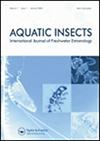1796年法国两种麻蝇的击鼓信号描述(翅翅目,麻蝇科)
IF 0.5
4区 农林科学
Q4 ENTOMOLOGY
引用次数: 0
摘要
摘要介绍了法国Nemoura lacustris Pictet(1865)和N. flexuosa Aubert(1949)的振动二重唱。湖泊Nemoura lakustris通过具有祖先信号模式的双向二重奏进行通信,其中雄性和雌性都表现出单相信号。狐獴的信号更为复杂,雄性群体的叫声由2-4个重复的群体组成,其特征是连续群体内的平均节拍数增加,群体间的间隔时间减少。女性的回答是由可变的节拍重复组成的,通常是前三个音程,最后一个音程比其他的要长。在没有雌性应答的情况下,存在第二个雄性应答信号(回复或回应),这是弯曲棘蝽呼叫的一个不寻常的特征。这个回答和雌性的回答很相似,可能是模仿雌性的回答,就像Boumans和Johnsen在2015年对其他石蝇的回答提出的那样,作为一种保护配偶的策略,或者它可以起到刺激潜在雌性伴侣的回答的作用,但这还有待证实。本文章由计算机程序翻译,如有差异,请以英文原文为准。
Description of drumming signals of two species of Nemoura Latreille, 1796 from France (Plecoptera, Nemouridae)
Abstract The vibrational duets of Nemoura lacustris Pictet, 1865 and N. flexuosa Aubert, 1949 are described from France. Nemoura lacustris communicates with a two-way duet having an ancestral signal pattern in which both male and female exhibit monophasic signals. Nemoura lexuosa has a more complex signal in which the male grouped call is composed by 2–4 repeated groups characterised by an increasing mean number of beats within successive groups and decreasing intergroup intervals. The female answer is composed of a variable repetition of beats usually with the three first intervals and the last one longer than others. An uncommon characteristic of the N. flexuosa call is the existence of a second male signal (reply or response) in the absence of the female answer. This reply is similar to the female answer, probably mimicking it and acting as a mate guarding tactic as previously proposed for the replies in other stoneflies by Boumans and Johnsen in 2015, or it could act stimulating the answer of potential female mates, but this should be confirmed.
求助全文
通过发布文献求助,成功后即可免费获取论文全文。
去求助
来源期刊

Aquatic Insects
生物-昆虫学
CiteScore
2.00
自引率
25.00%
发文量
27
审稿时长
>12 weeks
期刊介绍:
Aquatic Insects is an international journal publishing original research on the systematics, biology, and ecology of aquatic and semi-aquatic insects.
The subject of the research is aquatic and semi-aquatic insects, comprising taxa of four primary orders, the Ephemeroptera, Odonata, Plecoptera, and Trichoptera but also aquatic and semi-aquatic families of Hemiptera, Coleoptera, and Diptera, as well as specific representatives of Hymenoptera , Lepidoptera, Mecoptera, Megaloptera , and Neuroptera that occur in lotic and lentic habitats during part of their life cycle. Studies on other aquatic Hexapoda (i.e., Collembola) will be only accepted if space permits. Papers on other aquatic Arthropoda (e.g., Crustacea) will not be considered, except for those closely related to aquatic and semi-aquatic insects (e.g., water mites as insect parasites).
The topic of the research may include a wide range of biological fields. Taxonomic revisions and descriptions of individual species will be accepted especially if additional information is included on habitat preferences, species co-existing, behavior, phenology, collecting methods, etc., that are of general interest to an international readership. Descriptions based on single specimens are discouraged.
Detailed studies on morphology, physiology, behavior, and phenology of aquatic insects in all stadia of their life cycle are welcome as well as the papers with molecular and phylogenetic analyses, especially if they discuss evolutionary processes of the biological, ecological, and faunistic formation of the group.
 求助内容:
求助内容: 应助结果提醒方式:
应助结果提醒方式:


